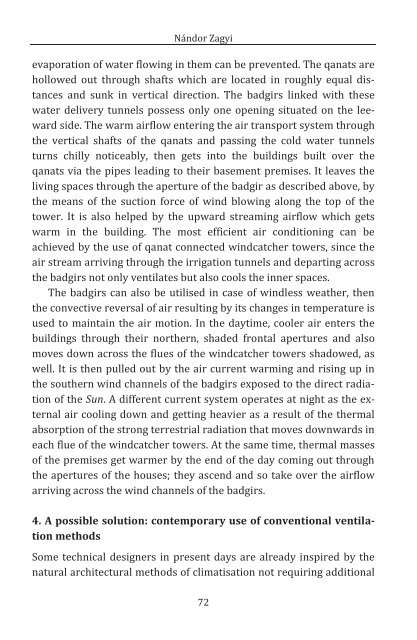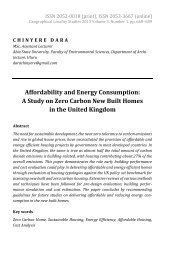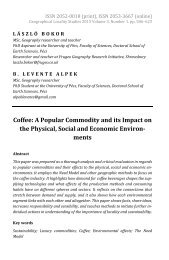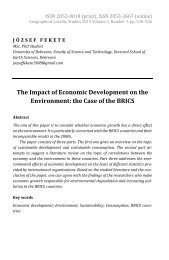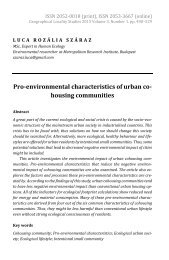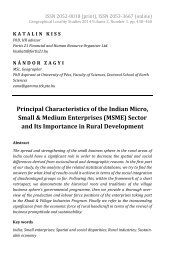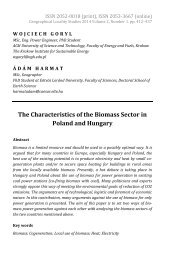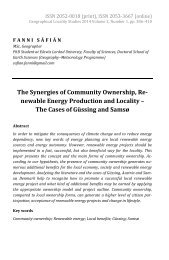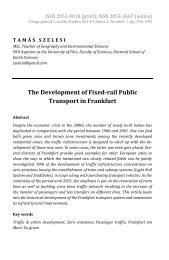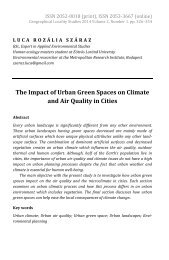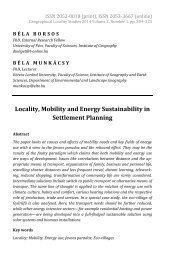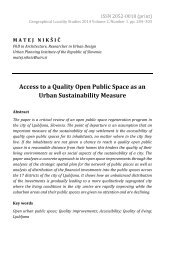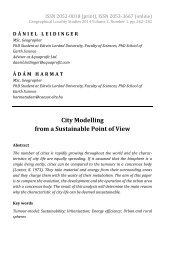Nándor Zagyi: Traditional Energy – Free Solutions for Ventilation and Air-Cooling in Arid Tropical Areas of Asia
Nowadays, more and more air-conditioning devices are installed to cool the inner spaces of dwelling and public buildings in the populous developing countries. Therefore, it is worth drawing attention to those traditional methods and architectural forms by which comfortable air conditions could be generated in the hot arid and semi-arid areas of the Planet.
Nowadays, more and more air-conditioning devices are installed to cool the inner spaces of dwelling and public buildings in the populous developing countries. Therefore, it is worth drawing attention to those traditional methods and architectural forms by which comfortable air conditions could be generated in the hot arid and semi-arid areas of the Planet.
Create successful ePaper yourself
Turn your PDF publications into a flip-book with our unique Google optimized e-Paper software.
<strong>Nándor</strong> <strong>Zagyi</strong><br />
evaporation <strong>of</strong> water flow<strong>in</strong>g <strong>in</strong> them can be prevented. The qanats are<br />
hollowed out through shafts which are located <strong>in</strong> roughly equal distances<br />
<strong>and</strong> sunk <strong>in</strong> vertical direction. The badgirs l<strong>in</strong>ked with these<br />
water delivery tunnels possess only one open<strong>in</strong>g situated on the leeward<br />
side. The warm airflow enter<strong>in</strong>g the air transport system through<br />
the vertical shafts <strong>of</strong> the qanats <strong>and</strong> pass<strong>in</strong>g the cold water tunnels<br />
turns chilly noticeably, then gets <strong>in</strong>to the build<strong>in</strong>gs built over the<br />
qanats via the pipes lead<strong>in</strong>g to their basement premises. It leaves the<br />
liv<strong>in</strong>g spaces through the aperture <strong>of</strong> the badgir as described above, by<br />
the means <strong>of</strong> the suction <strong>for</strong>ce <strong>of</strong> w<strong>in</strong>d blow<strong>in</strong>g along the top <strong>of</strong> the<br />
tower. It is also helped by the upward stream<strong>in</strong>g airflow which gets<br />
warm <strong>in</strong> the build<strong>in</strong>g. The most efficient air condition<strong>in</strong>g can be<br />
achieved by the use <strong>of</strong> qanat connected w<strong>in</strong>dcatcher towers, s<strong>in</strong>ce the<br />
air stream arriv<strong>in</strong>g through the irrigation tunnels <strong>and</strong> depart<strong>in</strong>g across<br />
the badgirs not only ventilates but also cools the <strong>in</strong>ner spaces.<br />
The badgirs can also be utilised <strong>in</strong> case <strong>of</strong> w<strong>in</strong>dless weather, then<br />
the convective reversal <strong>of</strong> air result<strong>in</strong>g by its changes <strong>in</strong> temperature is<br />
used to ma<strong>in</strong>ta<strong>in</strong> the air motion. In the daytime, cooler air enters the<br />
build<strong>in</strong>gs through their northern, shaded frontal apertures <strong>and</strong> also<br />
moves down across the flues <strong>of</strong> the w<strong>in</strong>dcatcher towers shadowed, as<br />
well. It is then pulled out by the air current warm<strong>in</strong>g <strong>and</strong> ris<strong>in</strong>g up <strong>in</strong><br />
the southern w<strong>in</strong>d channels <strong>of</strong> the badgirs exposed to the direct radiation<br />
<strong>of</strong> the Sun. A different current system operates at night as the external<br />
air cool<strong>in</strong>g down <strong>and</strong> gett<strong>in</strong>g heavier as a result <strong>of</strong> the thermal<br />
absorption <strong>of</strong> the strong terrestrial radiation that moves downwards <strong>in</strong><br />
each flue <strong>of</strong> the w<strong>in</strong>dcatcher towers. At the same time, thermal masses<br />
<strong>of</strong> the premises get warmer by the end <strong>of</strong> the day com<strong>in</strong>g out through<br />
the apertures <strong>of</strong> the houses; they ascend <strong>and</strong> so take over the airflow<br />
arriv<strong>in</strong>g across the w<strong>in</strong>d channels <strong>of</strong> the badgirs.<br />
4. A possible solution: contemporary use <strong>of</strong> conventional ventilation<br />
methods<br />
Some technical designers <strong>in</strong> present days are already <strong>in</strong>spired by the<br />
natural architectural methods <strong>of</strong> climatisation not requir<strong>in</strong>g additional<br />
72


